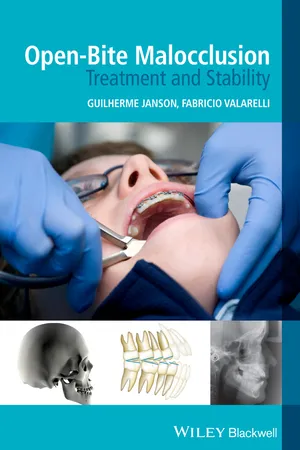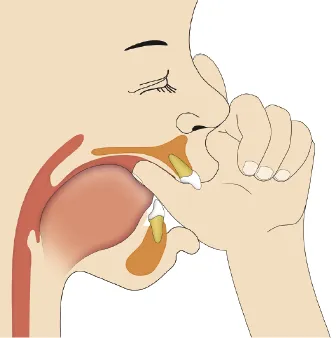In a normal occlusion, there is a balanced relationship among the oral structures, basal bones, teeth, and intra and extraoral musculature, reflecting in a correct function of the stomatognathic system (Moyers 1988). This is denominated the buccinator mechanism. Thus, the teeth are in a balanced position receiving opposing forces arising internally by the tongue and externally by the lips and cheeks (Figure 1.1) (Graber 1966).
The solution of this muscular balance for some abnormal function of the oral muscles has a negative impact on the teeth position and occlusion. Nonnutritive sucking habits, such as pacifier and thumb-sucking, atypical tongue thrust, and anterior tongue posture, all considered deleterious oral habits, can break this muscular balance.
Pacifier and thumb-sucking
Humans start sucking fingers, tongue, and lips during fetal life, in the maternal womb (Figure 1.2). At birth, the infant has a well-developed function of sucking to receive the nutrients essential for life. It is during suction developed in breastfeeding that the children not only get the nutrients that need to meet the physiological demands, as well as feelings of security, warmth, and acceptance necessary for their welfare and for their proper emotional development. At this stage, suction is a mean of communication of the infant with the environment (Newman 1990).
The early well-developed oral perception provides a sense of comfort, safety, and emotional satisfaction during sucking. When breastfeeding is not possible, the use of bottles with orthodontic nipples that resemble the anatomy of a woman's breasts is recommended, because they allow better contact of the tongue with the palate, as necessary for normal swallowing (Graber 1966) (Figure 1.3).
When a child is bottle-fed, his physiological demand is met, but the natural need to suck is not supplied in the few minutes spent in the mother's lap. Thus, the child can begin the compensating thumb or pacifier sucking (Graber 1966).
Pacifier or thumb-sucking are considered as mechanisms of emotional supply of the child. Consequently, pacifier or thumb-sucking in the early child development is considered normal. Through these habits, the child releases the emotional tensions from lack of affective care resulting from conflicting relationship between child and parents, which becomes a way to draw attention from people close to them (Moyers 1988). Parental opposition to these habits can determine negative psychological consequences. When children grow and develop other means of communication with the external environment, they usually spontaneously abandon the sucking habit. Interruption of sucking habits during the deciduous dentition can provide self-correction of the anterior open bite. However, persistence of the habit until the mixed dentition represents a deviation from normality, because these habits are potent etiologic malocclusion factors, particularly for anterior open bite (Ogaard et al. 1994; Bishara et al. 2006).
Pacifier or thumb-sucking act as mechanical obstacles, preventing eruption of the anterior teeth and establishing an open bite (Moyers 1988; Proffit et al. 2007) (Figure 1.4). Anterior open-bite malocclusion due to pacifier use is characteristically restricted to the anterior teeth and circular (Figure 1.5). Anterior open bite consequent to thumb-sucking is characterized by labial inclination of spaced maxillary incisors and lingual inclination of the mandibular incisors (Figure 1.6). Anterior open bite may be associated to maxillary constriction and uni- or bilateral posterior crossbite, because, during sucking, the tongue is lowered, without contact with the maxillary posterior teeth (Moore 1996).
However, a deleterious oral habit does not always necessarily results in an open bite. First, it depends on how the habit is exercised, that is, it depends on the duration (for how long it is exercised, e.g., for how long the child keeps the pacifier in position), on the frequency (number of times per day it is exercised), and on the intensity (the amount of force developed by the habit) of the habit. These factors are important in the etiology of this malocclusion and are known as Graber's Trident (Graber 1958). Besides its mode of action, another important factor in the onset of an anterior open bite is the facial growth pattern. In the presence of deleterious habits, patients with vertical growth pattern have a greater tendency to manifest anterior open bite than patients with horizontal growth pattern (Schendel et al. 1976; Nielsen 1991). Therefore, the manifestation of an open bite depends on the association of environmental (Graber's Trident) and genetic factors (facial growth pattern). This explains why there are children with habits but without an open bite (Figure 1.7).
Prevention requires that intervention of thumb-sucking habit is started as soon as possible. Several studies (Graber 1966; Moore 1996; Vadiakas et al. 1998) have suggested the use of orthodontic pacifiers as a preventive step in thumb-sucking habit, based on findings that pacifier habit tends to be discontinued earlier than thumb-sucking habit.







